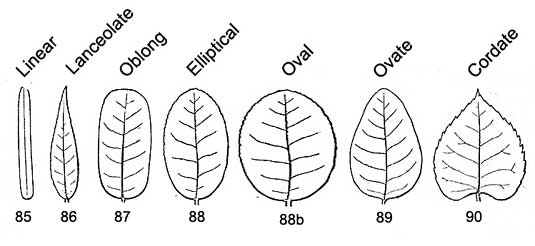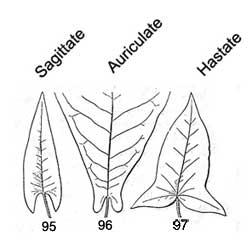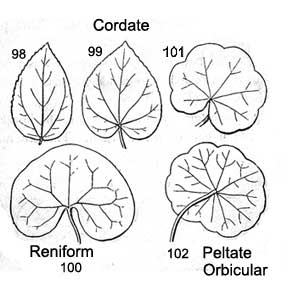
FIG. 85 - 90. Various forms of feather-veined leaves.
Text and Figures from Asa Gray's Lessons in Botany and Vegetable Physiology, pp 57-60. 1
149. Forms of Leaves as to General Outline It is necessary to give names to the principal shapes, and to define them rather precisely, since they afford the easiest marks for distinguishing species. The same terms are used for all other flattened parts as well, such as the petals of the flowers; so that they make up a great part of the descriptive language of Botany. We do not mention the names of common plant; which exhibit these various shapes. It will be a good exercise for young students to look them up and apply them.

FIG. 85 - 90. Various forms of feather-veined leaves.
150. Beginning with the narrower and proceeding to the broadest forms, a leaf is siad to be
Linear (Fig. 85), when narrow, several times longer than and of the same breadth throughout.
Lanceolate, or lance-shaped, when several times longer than amI tapering upwards (Fig. 86), or both upwards and down.
Oblong (Fig. 87), when nearly twice or thrice as long as broad.
Elliptical (Fig. 88) is oblong with a flowing outline, the two alike in width.
Oval is the same as broadly elliptical, or elliptical with the breadth considerably more than half the length.[Fig 88b, inserted on the original -JackPine]
Ovate (Fig. 89), when the outline is like a section of a hen's lengthwise, the broader end downward.
Orbicular, or rotund (Fig. 102), circular in outline, or nearly so.
 FIG. 91. Oblanceolate, 92. spatulate, 93. obovate, |
151. When the leaf tapers towards the base instead of upwards it may be
Oblanceolate (Fig. 91), which is lance-shaped, with the mo tapering end downwards; Spatulate (Fig. 92), roun ed above and long and narro below, like a spatula;
Obovate (Fig. 93), or inversely ovate, that is, ovate with the narrower end down; or
Cuneate, or cuneiform, that is, wedge-shaped (Fig. 94), broad above and tapering by straight lines to an acute angle at the base
.152. As to the Base, its shape characterizes several forms, such as
Cordate, or heart-shaped (Fig. 90, 99, 8), when a leaf of an ova form, or something like it, has the outline of its rounded base turn in (forming a notch or sinus) where the stalk is attached.
Reniform, or kidney-shaped (Fig. 100), like the last, only round and broader than long.

FIG. 95. Sagittate, 96. auriculate, |
 FlG. 98-102. Various forms of radiate-veined leaves. |
Auriculate, or eared, having a pair of small and blunt projections, or ears, at the base, as in one species of Magnolia (Fig. 96).
Sagittate, or arrrow-shaped, where such ears are pointed and turned downwards, while the main body of the blade tapers upwards to a point, as in the campion Sagittaria or Arrow-head, and in the Arrow-leaved Polygonum (Fig. 95).
Hastate, or halberd-shaped, when such lobes at the base point outwards, giving the leaf the shape of the halberd of the olden time, as in another Polygonum (Fig. 97).
Peltate, or shield-shaped, (Fig. 102,) is the name applied to a curious modification of the leaf, commonly of a rounded form, where the foots talk is attached to the lower surface, instead of the base, and therefore is naturally likened to a shield borne by the outstretched arm. The common Watershield, the Nelumbium, and the White Water-lily, and also the Mandrake, exhibit this sort of leaf. On comparing the shield-shaped leaf of the common Marsh Pennywort (Fig. 102) with that of another common species (Fig. 101), we see at once what this peculiarity means. A shield-shaped leaf is like a kidney-shaped (Fig. 100) or other rounded leaf, with the the base brought together and united.